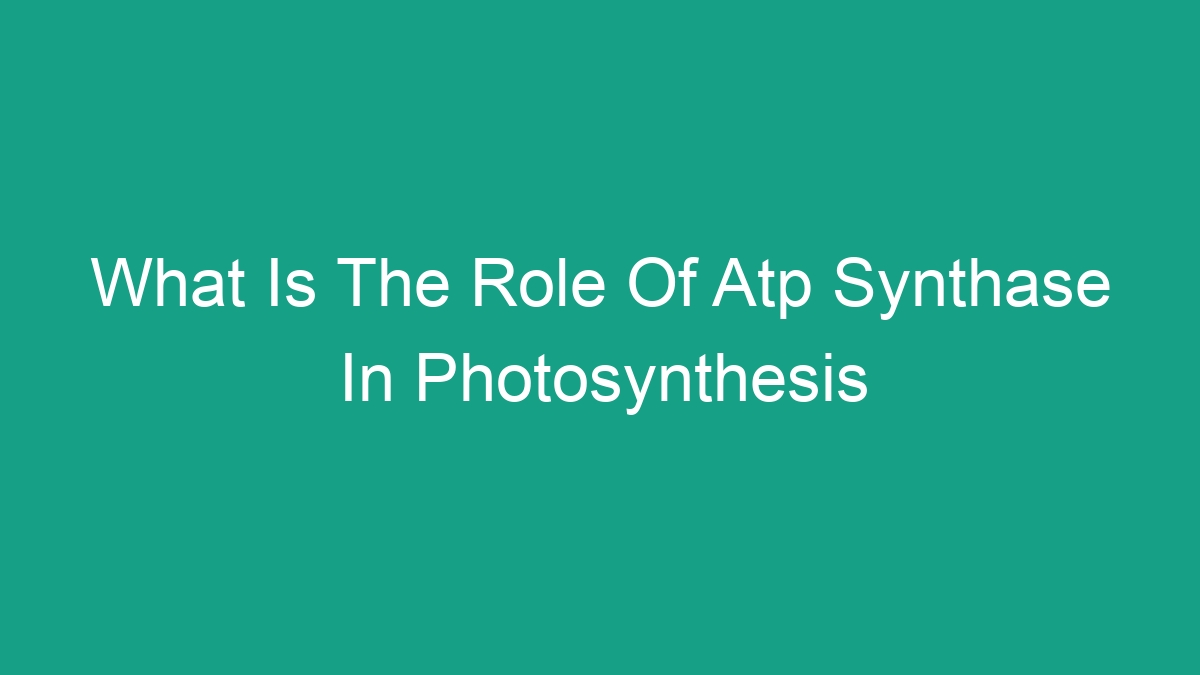
Photosynthesis is a crucial process that occurs in plants, algae, and some bacteria. It is responsible for producing oxygen and organic compounds, which serve as the basis for the food chain. At the heart of the photosynthetic process is the production of ATP, or adenosine triphosphate, a molecule that stores and releases energy for cellular processes. ATP synthase is a key enzyme involved in the final steps of ATP production during photosynthesis. In this article, we will explore the role of ATP synthase in photosynthesis and its importance in the overall functioning of plants and other photosynthetic organisms.
Overview of Photosynthesis
Photosynthesis is the process by which green plants, algae, and some bacteria convert light energy, usually from the sun, into chemical energy stored in glucose and other organic compounds. This process occurs in the chloroplasts of plant cells, specifically in the thylakoid membranes. The overall chemical equation for photosynthesis can be represented as:
6CO2 + 6H2O + light energy → C6H12O6 + 6O2
This equation indicates that carbon dioxide and water, in the presence of light energy, are converted into glucose and oxygen. The light-dependent reactions of photosynthesis occur in the thylakoid membranes, where ATP and NADPH (another energy-carrying molecule) are produced. These molecules are then used in the Calvin cycle, the light-independent reactions of photosynthesis, to produce glucose and other carbohydrates.
Role of ATP Synthase in Photosynthesis
ATP synthase is an enzyme complex located in the thylakoid membrane of the chloroplast. It plays a crucial role in the production of ATP during the light-dependent reactions of photosynthesis. ATP is an energy carrier that powers various cellular processes in plants, such as the synthesis of glucose during the Calvin cycle, as well as other metabolic reactions.
The thylakoid membrane houses the components necessary for the photosynthetic electron transport chain, including photosystem II, cytochrome complex, photosystem I, and ATP synthase. As light energy is absorbed by chlorophyll and other pigments, it energizes electrons, which then flow through the electron transport chain, ultimately leading to the generation of a proton gradient across the thylakoid membrane.
It is this proton gradient that drives the production of ATP. ATP synthase acts as a molecular turbine, harnessing the energy from the proton gradient to catalyze the formation of ATP from ADP (adenosine diphosphate) and inorganic phosphate. This process is known as chemiosmosis and is essential for the conversion of light energy into chemical energy in the form of ATP.
Importance of ATP Synthase in Photosynthesis
The role of ATP synthase in photosynthesis is critical for the generation of ATP, which serves as the primary energy currency in living organisms. Without ATP, various cellular processes, including the synthesis of glucose and other organic compounds, would not be possible. ATP is required for the Calvin cycle, which is responsible for fixing carbon dioxide and producing sugars that are essential for the growth and development of plants.
Furthermore, the production of ATP by ATP synthase enables the conversion of light energy into chemical energy, providing the necessary fuel for metabolic activities and growth. This energy is used for processes such as active transport of molecules across cell membranes and the synthesis of macromolecules like proteins and nucleic acids.
Regulation of ATP Synthase Activity
The activity of ATP synthase is tightly regulated to ensure that the production of ATP matches the energy demand of the cell. The proton gradient across the thylakoid membrane, which drives ATP synthesis, is maintained by the flow of electrons through the photosynthetic electron transport chain.
Factors such as light intensity, availability of carbon dioxide, and the overall metabolic state of the plant can influence the rate of electron transport and thus the production of ATP by ATP synthase. For example, in low light conditions, the rate of electron transport decreases, leading to a lower production of ATP. Conversely, under high light intensity, the flow of electrons increases, resulting in higher ATP synthesis to meet the increased energy demand of the plant.
FAQs
1. What is the difference between ATP and ADP?
ATP (adenosine triphosphate) and ADP (adenosine diphosphate) are both molecules involved in energy transfer within cells. The main difference between them is the number of phosphate groups. ATP has three phosphate groups, while ADP has two. When energy is needed in a cell, ATP releases one of its phosphate groups, becoming ADP and releasing energy in the process.
2. How is ATP used in the cell?
ATP serves as the primary energy currency in cells. It provides the energy necessary for processes such as muscle contraction, active transport of molecules across cell membranes, and the synthesis of macromolecules like proteins and nucleic acids. In photosynthetic organisms, ATP is also essential for the fixation of carbon dioxide and the production of sugars during the Calvin cycle.
3. How does ATP synthase function in ATP production?
ATP synthase is an enzyme complex that catalyzes the formation of ATP from ADP and inorganic phosphate. It does so by utilizing the energy from a proton gradient across a membrane, often generated during processes like photosynthesis or cellular respiration. As protons flow through ATP synthase, it drives the synthesis of ATP, thus converting the proton gradient’s potential energy into chemical energy stored in ATP.
In conclusion, ATP synthase plays a crucial role in the production of ATP during photosynthesis. It harnesses the energy from the proton gradient across the thylakoid membrane to catalyze the formation of ATP from ADP and inorganic phosphate. This process is essential for the conversion of light energy into chemical energy, enabling the synthesis of glucose and other organic compounds crucial for the growth and development of plants and other photosynthetic organisms.



